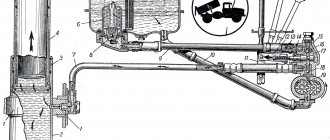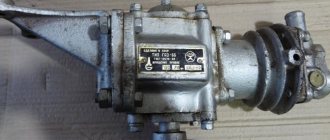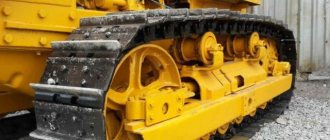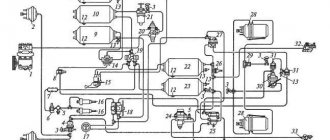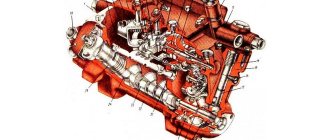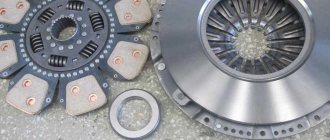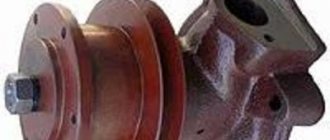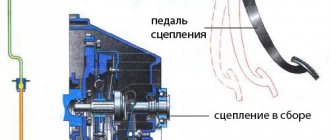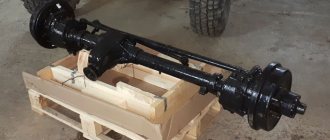Any internal combustion engine requires a high-quality cooling system. This is due to the peculiarities of his work. A mixture of air and fuel is burned inside the cylinders, causing the cylinder block, head, exhaust system and other adjacent systems to heat up to critical temperatures, especially if the engine is turbocharged (read about why there is a turbocharger in a car and how it works Here). Although these elements are made of heat-resistant materials, they still require cooling (if they are critically heated, they can deform and expand).
For this, automakers have developed different types of cooling systems that are capable of maintaining the operating temperature of the engine (what this parameter should be is described in another article ). One of the components of any cooling system is the fan. We will not consider the structure of this element itself now - there is already another review . Let's focus on one of the drive options for this mechanism - viscous coupling.
Let's consider what kind of device it has, what the principle of its operation is, what malfunctions there are, as well as options for repairing the mechanism or replacing it.
Operating principle of viscous cooling fan coupling
A modern car is equipped with a cooling system whose fan is electrically driven. But sometimes there are machine models in which a coupling with a viscous drive mechanism is installed. Due to the design features of this system component, it is only used on vehicles with rear-wheel drive. In this case, the engine stands longitudinally in the engine compartment. Since most modern car models are equipped with a transmission that transmits torque to the front wheels, this modification of fans can rarely be found on passenger cars.
The mechanism operates according to the following principle. The fan drive itself, in the housing of which a viscous coupling is installed, is connected to the crankshaft pulley using a belt. There are car models in which the clutch rotor is connected directly to the crankshaft. There are also options connected to the camshaft pulley.
The rotor housing of the mechanism will contain two disks, one of which is mounted on the drive shaft. The distance between them is minimal so that blocking occurs as quickly as possible in accordance with the heating temperature of the working substance or changes in its viscosity as a result of mechanical action (non-Newtonian fluid). The second disk is attached to the fan impeller located behind the cooling radiator (read more about the different modifications and how this component of the system works in another review ). The rotor housing is installed motionless so that the drive cannot constantly rotate the entire structure (these are old designs), but in modern designs the rotor is part of the fan structure (the housing itself rotates, to which the impeller is attached).
Until the mechanism is locked, torque is not transmitted from the driving element to the driven element. Thanks to this, the impeller will not rotate constantly during operation of the internal combustion engine. In winter, as well as during the process of warming up the power unit (read separately about why to warm up the engine ), the cooling system should not work. As long as the motor does not need cooling, the viscous coupling rotor cavity remains empty.
As the engine heats up, the bimetallic strip begins to deform. The plate gradually opens the channel through which the working fluid is supplied. It could be thick oil, silicone material, viscous gel-like substance, etc. (it all depends on how the manufacturer transfers torque from the pulley to the driven disk of the device), but more often silicone is used to create such substances. Some viscous coupling models use dilatant fluid.
Its peculiarity is that the viscosity of this substance changes depending on the rate of deformation of the liquid volume. As long as the drive discs move smoothly, the liquid remains fluid. But as soon as the speed of the leading element increases, a mechanical effect is exerted on the substance, which causes its viscosity to change. Modern viscous couplings are filled with such a substance once, and it does not need to be replaced throughout the entire working life of the coupling.
Viscous couplings can be used not only in this mechanism. A little later we will look at where else such a mechanism can be installed. As for the operation of a fan with a viscous coupling, as soon as the bimetallic plate opens the inlet channel, the mechanism structure will gradually begin to be filled with the working substance. Thanks to this, a connection is formed between the master and slave disks. This mechanism does not require high pressure in the cavity to operate. To ensure improved connection between the disks, their surface is made with small ribs (in some modifications of the viscous coupling, each disk element is perforated).
So, the rotational force from the engine to the fan blades is transmitted through a viscous material entering the rotor cavity and falling on the perforated coating of the disks. The viscous coupling body is completely filled with this substance, due to which centrifugal force is additionally generated, as in an engine pump (details on how the cooling system water pump works are described in another article ).
1 — valve slightly open (warm up engine); 2 — slight bend of the bimetallic plate (heated motor); 3 - fully curved bimetallic plate (engine is hot); 4 — valve is fully open (motor is hot); 5 — drive from internal combustion engine; 6 — viscous coupling drive; 7 - oil in the mechanism.
When the antifreeze in the radiator cools to the required degree, the bimetallic plate returns to its original shape and a drain channel opens in the coupling. The working fluid, under the influence of centrifugal force, moves into the reservoir, from where, if necessary, it again begins to be pumped into the coupling cavity.
The operation of a viscous coupling, if the working fluid is based on silicone, has two features:
- The connection between the disks is ensured not only by centrifugal force. The faster the driving element rotates, the more the silicone substance is mixed. The intensity makes it thicker, which enhances the engagement of the disk group;
- As the liquid heats up, it expands, which increases the pressure inside the structure.
During the uniform movement of the machine, the motor operates at relatively stable speeds. Thanks to this, the liquid in the coupling does not mix intensively. But when the driver begins to accelerate the vehicle, a difference appears between the rotation of the driving and driven disks, due to which the working environment is intensively mixed. The viscosity of the fluid increases, and the rotational motion begins to be transmitted with greater efficiency to a group of driven disks (in some models, not one disk is used, but two sets, each of the elements of which alternates with each other).
If the difference in rotation of the disc packs is very different, the substance becomes almost solid, which leads to the clutch locking. A viscous coupling, which is installed in the vehicle transmission instead of the center differential, has a similar operating principle. In this configuration, the car is front-wheel drive by default, but when each drive wheel begins to slip, the sharply increased difference in torque activates the clutch lock and the rear axle engages. A similar mechanism can also be used as a cross-axle differential (read more about why a car needs a differential in another article ).
Unlike the mechanisms used in the transmission, the modification for the cooling fan is equipped with a special reservoir in which the volume of the working substance is stored. When the engine is at the warm-up stage, the thermostat in the OS line is closed (the operation of the thermostat is described in detail here ), and antifreeze circulates in a small circle. In cars that are operated in cold regions with frosty winters, an internal combustion engine preheating system can be used for this purpose (read about it in detail separately ).
While the system is cold, the drain valve located in the clutch housing is open, and the rotating drive disk throws the working fluid coming from the reservoir back into the container. As a result, the viscous coupling does not work due to the lack of clutch between the discs. The fan blades do not rotate and the radiator is not blown. As the engine continues to burn the air-fuel mixture, it heats up.
The moment the thermostat opens, coolant (antifreeze or antifreeze) begins to flow into the circuit to which the radiator heat exchanger is connected. The heating of the bimetallic plate (it is attached to the viscous coupling body in the front part, as close as possible to the radiator) occurs due to the heat coming from the radiator. Due to its deformation, the outlet hole is blocked. The working substance is not ejected from the cavity, and it begins to fill with liquid. The liquid gradually expands and becomes thicker. This ensures a smooth connection of the driven disk mounted on the driven shaft with the impeller.
As a result of the rotation of the fan impeller, the air flow through the heat exchanger increases. Then the cooling system works in the same way as when installing a fan with an electric motor. When the coolant cools to the desired parameter, the bimetallic plate begins to take its original shape, opening the drain channel. The substance is removed into the reservoir under the influence of inertia. The adhesion between the discs gradually decreases and the fan gradually stops.
Replacing a viscous coupling using the example of an Audi A6 C5
On these vehicles, the fan with clutch and pulley is mounted on a separate axle and is driven by an auxiliary belt. The clutch rotor is screwed directly onto the threads of the pulley bushing.
It won't take much time to replace:
- since it will not be possible to hold the pulley by the belt, you will have to fix it with a special device through the existing holes; it is quite easily made from a strip of iron and two bolts with nuts in place, or you can try to get by with an L-shaped hexagon from the kit;
- Having fixed the pulley, use a 32 mm open-end wrench to unscrew the rotor nut; remember that it has a left-hand thread and must be turned clockwise to unscrew;
- By unscrewing the rotor, you can remove the impeller assembly with the coupling and disconnect them by unscrewing the four bolts.
The new clutch is installed in the reverse order, after which it can be checked as indicated above, although completely new products have significant rotation resistance even when cold.
Device and main components
Let's consider what components a viscous coupling consists of. The device consists of the following key elements:
- Hermetically sealed housing (since it is constantly filled with liquid, this part of the mechanism must be sealed to avoid leaks);
- Two packages of discs with perforations or ribs. One packet is the master, and the other is the slave. Regardless of the number of disk elements in each package, they all alternate with each other, due to which the liquid is mixed more efficiently;
- A dilatant fluid that transmits torque in a closed housing from one set of disks to another.
Each manufacturer uses its own base for the working fluid, but often it is silicone. When an organic liquid is vigorously stirred, its viscosity increases until it becomes almost solid. Also, modern viscous couplings are presented in the form of a drum, the body of which is attached to the impeller with bolts. In the center of the housing there is a freely rotating shaft with a nut, to which the drive pulley or the motor shaft itself is screwed.
Operating principle and purpose
To understand the operating principle of a viscous coupling, you need to carefully familiarize yourself with its design. All its parts are fixed in one sealed housing, which contains two rows of disks connected by a driven and drive shaft. Each row is equipped with holes and protrusions with a small distance from each other. A high-viscosity liquid consisting of silicone additives flows inside the viscous coupling. It is characterized by a special composition that allows it to effectively service the drive system and provide the required torque.
A little about the use of viscous couplings
In addition to the cooling system of some car models, viscous coupling can be used in another vehicle system. This is a plug-in all-wheel drive (what it is and how such a car works is described in a separate article ).
More often, modifications of such a transmission with a viscous coupling are installed in some crossovers. They replace the center differential, so that when the drive wheels slip, the group of discs begins to spin faster, causing the fluid to become more viscous. Thanks to this effect, the driving disk begins to transmit torque to the driven counterpart. Such properties of the viscous coupling allow, if necessary, to connect the free axle to the vehicle transmission.
This automatic mode of operation does not require the use of complex electronics. Of the other varieties with which the secondary axle can be connected to the leading one, this is the 4Matic all-wheel drive system (described here ) or xDrive (there is also a separate review ).
The use of viscous clutches in all-wheel drive makes sense due to their simple design as well as reliability. Since they operate without electronics or auxiliary devices, viscous couplings are cheaper than their electromechanical counterparts. Also, the design of the mechanism is quite durable - it can withstand pressure up to 20 atm. There are cases where a car equipped with a viscous coupling in the transmission worked for more than five years after being sold on the secondary market, and before that it also worked properly for several years.
The main disadvantage of such a transmission is the late activation of the secondary axle - the drive wheels must skid strongly for the clutch to lock. Also, the driver will not be able to forcefully connect the second axle if the road situation requires activating all-wheel drive. Plus, the viscous coupling can conflict with the ABS system (read more about how it works here ).
Depending on the car model, the driver may encounter other disadvantages of such a mechanism. Due to these shortcomings, many automakers are abandoning the use of viscous couplings in transmissions of all-wheel drive vehicles in favor of their electromechanical counterparts. An example of such mechanisms is the Haldex coupling. The features of this type of coupling are described in another article .
How to disassemble the coupling
- First of all, remove the cooling fan. As a rule, to remove it you need to unscrew 3 or 4 bolts.
- We inspect the coupling.
- Let's dismantle it.
If the coupling is dismountable, then you can repair it:
- To do this, first drain the oil through a special hole.
- Remove the plate that covers the bearing.
- The bearing is removed with a puller. You can make a puller with your own hands, or you can buy one.
- Press in a new bearing.
- They put on a record.
- Pour in gel or oil.
- Attach the fan.
How can you tell if there is enough fluid in the viscous coupling? If, when the engine is stopped, the fan stops abruptly, then there is not enough liquid.
It is recommended to fill the viscous coupling with silicone-based oil. Refilling is done with a syringe.
If there are mechanical failures, then it is not repaired.
Replacing the old one and installing a new viscous coupling is an easy job, even a beginner can do it. After dismantling the device, you need to remove the fan impeller. Install a new coupling. When installing a new coupling, you must tighten the bolts firmly, but without stripping the threads. Then you need to install the fan in place.
Functionality check
Checking the viscous fan coupling is not difficult. According to the vehicle operating instructions, this must be done first on a cold internal combustion engine, and then after it reaches operating temperature. Here's how the mechanism works in these modes:
- Cold system . The engine is running, the driver briefly increases the engine speed several times. A working device will not transmit torque to the impeller, since the outlet must remain open and there is no interlocking between the discs.
- Hot system . In this case, depending on the temperature of the antifreeze, the shutoff of the drain circuit will depend, and the fan will rotate slightly. The revs should increase when the driver presses the gas pedal. At this moment, the engine temperature rises, the pump drives hot antifreeze along the line to the radiator, and the bimetallic plate is deformed, blocking the drainage of the working fluid.
The mechanism can be checked independently without diagnostics at a service station in the following ways:
- The motor doesn't work. Try to rotate the fan blades. There should be some resistance felt. The fan should not rotate by inertia;
- The engine starts. A slight noise should be heard inside the mechanism for the first few seconds, which gradually subsides due to some filling of the cavity with the working fluid.
- After the engine has been running for a while, but has not yet reached operating temperature (the thermostat is not open), the blades will rotate slightly. We roll a sheet of paper into a tube and insert it into the impeller. The fan should lock, but there should be some resistance.
- The next step involves dismantling the coupling. The device is immersed in boiling water to heat up its internal parts. An attempt to rotate the blades should be accompanied by resistance from the mechanism. If this does not happen, it means that there is not enough viscous substance in the coupling. During this work, you can additionally dismantle the heat exchanger of the cooling system and wash it.
- Check for longitudinal play. In a working mechanism, this effect should not occur, since a constant gap must be maintained between the disks. Otherwise, the mechanism needs to be repaired or replaced.
There is no need to carry out further inspection if at any stage a malfunction of the fan is detected. Regardless of whether the clutch needs to be repaired or not, there is always a need to service the cooling system at the end of the summer season. To do this, the heat exchanger is removed and any contamination in the form of fluff, leaves, etc. is removed from its surface.
Symptoms of a problem
Since the fan in the engine compartment is designed to forcibly cool the engine during operation, overheating of the power unit is one of the main signs of a clutch malfunction. It is worth noting that this is also a symptom of failure of other elements included in the cooling system, for example, the thermostat.
The motor will overheat due to the fact that a leak has formed in the coupling, and the fluid either poorly transmits rotational forces between the disks or does not provide this connection at all. Also, such a problem can occur as a result of untimely operation of the bimetallic plate.
When the clutch does not operate properly, the impeller stops rotating or performs its function with minimal efficiency, no additional cool air flow is supplied to the heat exchanger, and the motor temperature quickly rises to a critical value. If the car is in motion, the radiator is blown efficiently, and forced airflow is not required, but when the car stops, the engine compartment is poorly ventilated, and all mechanisms and assemblies are heated.
Another sign of problems with the viscous coupling can be identified by starting a cold engine and observing how the fan behaves. When the unit is not warmed up, this mechanism should not rotate. the opposite effect is observed when the working substance loses its properties, for example, it hardens. Due to longitudinal play, the discs can be in constant contact with each other, which also leads to constant rotation of the blades.
Main causes of malfunction
The key reason for problems with the operation of a viscous coupling is the natural wear of the mechanism parts. Therefore, each manufacturer establishes certain regulations for the scheduled maintenance of vehicle mechanisms. The minimum working life is from 200 thousand kilometers of vehicle mileage. On the secondary market, a car with a viscous fan coupling will always have decent mileage (you can read about how to determine whether the mileage on a used car is twisted in another article ), so there is a high probability that you will need to pay attention to the mechanism in question.
Here are some other reasons for viscous coupling failure:
- Deformation of the bimetallic plate due to frequent heating/cooling;
- Bearing failure due to natural wear;
- Broken impeller blade. Because of this, runout is formed, which accelerates bearing wear;
- Depressurization of the housing, which causes leakage of the working substance;
- Loss of liquid properties;
- Other mechanical failures.
If the driver does not monitor the cleanliness of the mechanism or heat exchanger, then this is another reason for the failure of the device.
The moment of activation of the mechanism must be monitored at least once a month, especially in summer, since during hot periods the motor especially needs cooling. Even if the new viscous coupling does not do its job well, there may be a reason to install an electric, more powerful analogue. By the way, some motorists install an electric fan as an auxiliary element for greater effect.
Repair and replacement
Almost all modern cars are equipped with non-separable viscous couplings. Therefore, repair of this unit is impossible. But there are models mainly made in Germany with the ability to replace the bearing and add fluid.
This element has several faults. When a bearing fails, you can hear a characteristic howl from under the hood. If there is a lack of fluid, the fan's efficiency decreases. It begins to spin more slowly, until it stops completely. The same can be observed when disks are damaged.
How repairs are made
So, when the driver notices that the car’s engine has begun to overheat more often, and other parts of the cooling system are working properly, the viscous coupling should be diagnosed (the procedure is described a little higher). As we have discussed, one of the device failures is a leak of silicone substance. Although the user manual states that this fluid is poured into the mechanism once at the factory, and it cannot be replaced, the motorist can independently replenish the volume lost as a result of depressurization or replace the fluid with a fresh one. The procedure itself is simple. It is much more difficult to find the right working substance.
In stores, these products are sold under the following names:
- Viscous coupling repair fluid;
- Oil to viscous coupling;
- Silicone substance for viscous couplings.
The repair of the viscous coupling, which is used in the all-wheel drive system, deserves special attention. In this case, it is recommended to select a new liquid in accordance with what type of substance was used before. Otherwise, after repair, the transmission will not connect the second axis or will not work correctly.
To repair the viscous coupling, which is used in the cooling fan drive, you can use a universal analogue. The reason is that the torque transmitted through the disks of the mechanism is not as great as in the transmission (more precisely, such a large power take-off is not required in this case). The viscosity of this material is often sufficient for the mechanism to operate.
Before you begin repairing the coupling, you need to check how much silicone fluid is in the device. Each fan model may use a different volume of substance, so information about the required level should be found in the user manual.
To add or replace fluid in the clutch, you must:
- Remove the mechanism from the car and remove the impeller from the coupling;
- Next, you need to lay the product horizontally;
- The pin installed behind the spring-loaded plate is removed;
- There must be a drain hole in the coupling housing. If it is not there, then you will need to drill it out yourself, but it is better to entrust this procedure to a specialist so that the disks are not damaged;
- After these procedures, about 15 ml of liquid is pumped inside through the drain hole using a syringe. The entire volume must be divided into several portions. During the pouring process, you need to wait about a minute to a minute and a half so that the viscous substance is distributed in the gaps of the disks;
- The mechanism is being reassembled. To keep the device clean, you need to wipe it, removing any remaining silicone substance from the surface, which will contribute to accelerated contamination of the case.
When the driver hears noise coming from the fan while rotating, this indicates bearing wear. Replacing this part is carried out according to the same procedure as filling the liquid, with the exception of several additional manipulations. The liquid itself must be replaced with fresh one.
To remove the bearing from the housing, you must use a bearing puller. Before doing this, it is necessary to remove the flaring along the edge of the mechanism housing (it prevents the bearing from falling out of the seat). It is not recommended to dismantle the bearing using any improvised means, since in this case damage to the contact surfaces and disks cannot be avoided. Next, a new bearing is pressed in (for this you need to use the option with a closed socket with the appropriate dimensions).
In no case should the repair process be accompanied by great efforts on one of the shafts of the device. The reason is that even a slight deformation of one of the disks is enough, and the coupling will be unsuitable for further use. During the repair process, you may notice that there is a thin film of lubricant on the device. It should not be removed.
As practice shows, most motorists who decide to repair the viscous fan coupling themselves encounter difficulties associated with assembling the mechanism. In order not to confuse what is connected where, it is better to capture each stage of disassembly on a camera. Thanks to this, step-by-step instructions for reassembling the device will be available.
As mentioned a little earlier, instead of a fan with a viscous coupling, you can install an electric analogue. To do this you will need:
- Buy a fan of suitable size with an electric motor (often these cooling system components are sold already mounted on a radiator);
- Electrical cable (minimum core cross-section must be 6 square millimeters). The length of the wiring depends on the size of the engine compartment. It is not recommended to lay wiring directly or near vibrating and sharp elements;
- 40 amp fuse;
- Relay for turning the fan on/off (the minimum current with which the device can operate must be 30A);
- Thermal relay that operates at a temperature of 87 degrees.
The thermal relay is installed on the radiator inlet pipe or you need to glue it to the metal part of the pipeline, as close as possible to the thermostat. The electrical circuit is assembled according to an analogue of VAZ models (the diagram can be downloaded from the Internet).
DIY viscous coupling repair
If this device stops working, you must first refill it with gel or special oil.
There are not many specialists who can repair viscous couplings. Sometimes it is cheaper and faster to buy a new device or switch to an electric fan.
To install an electric engine cooling fan, you need the following parts:
- The fan itself is electrically driven.
- Wires with a cross-sectional area of 6 mm2.
- 40 Amp fuse.
- Relay regulator 30 Amp or more.
- A thermal relay, for example, from a Lada car, which is activated when the engine heats up to 87 degrees.
The thermal relay can be glued to the radiator or next to the thermostat on a metal surface.
After this, you need to make a connection diagram, like on VAZ cars. The VAZ electrical circuit for connecting the fan will last about 5 years.
Selecting a new device
Like selecting any other part for a car, finding a new viscous fan coupling is not difficult. To do this, you can use the services of online stores. Even if the device that this or that store offers is too expensive, you can at least find out the catalog number of the mechanism. This will make it easier to find the product on other platforms. By the way, many online car stores offer both original spare parts and their analogues.
It is best to search for original products by VIN code (read about what information about the car it contains, as well as where to find it in the car, in another article ). Also, in a local auto store, selection can be carried out according to the vehicle data (date of manufacture, model, make, as well as engine characteristics).
An important factor when choosing any device, including a viscous coupling for a cooling system fan, is the manufacturer. When purchasing many auto parts, you should not trust packaging companies, but this does not apply to viscous couplings. The reason is that there are not many companies involved in the manufacture of these products, so in most cases the product will be of the required quality, and the difference between the original and the analogue will be the cost. Such companies usually supply couplings to factories where vehicles are assembled.
The products of the following manufacturers are worthy of attention:
- German companies Behr-Hella, Meyle, Febi and Beru;
- Danish manufacturer Nissens;
- South Korean company Mobis.
The products of Turkish and Polish manufacturers that have recently entered the market deserve special attention. If you have the opportunity to choose another manufacturer, then it is better not to be tempted by the budget price. To determine the reputation of a company, it is enough to pay attention to its product range.
Usually, decent viscous couplings are sold by companies engaged in the production of radiators and other elements of cooling systems for transport. If you have experience in purchasing a high-quality radiator, then you should first look for a suitable viscous coupling in the catalog of this manufacturer.
Parsing
All work begins with removing the fan. It is usually secured with 3 or 4 bolts. By removing it, you can assess the condition of the coupling. If you have a collapsible model, you can try to repair the part. Before removing the bearing, you need to drain the liquid through a special hole. Next, use a screwdriver to remove the plate covering the bearing. And it is pulled out using a special puller. After this, a new spare part is installed.
The new bearing is pressed in using a special mandrel. You cannot do this with a hammer or hit the bearing in any way. This may damage it. A lack of fluid can be determined by the sudden stop of the fan after you turn off the engine. The motor also begins to overheat.
You should add special silicone-based viscous coupling oil. This is done using a special syringe. You can also use a medical one, the largest one you can find. Failure of the discs can only be determined by disassembling the clutch. They cannot be repaired.
Replacing the viscous coupling is not difficult. After removing the assembly from the engine, unscrew the fan impeller. Install a new coupling. At the same time, pay attention to the tightening of the bolts. They must be screwed in properly. After this, the fan is installed in place. In many cases, it is easier to immediately replace the entire viscous coupling without bothering with its repair.
Conclusion
. The cooling system is an important component of any car. At the same time, the efficiency of even the best systems is not maximum. The operating principle of the viscous cooling fan coupling makes this system the most efficient of all those currently in use. Knowing how such a clutch works, you can promptly identify its malfunction.
Advantages and disadvantages
Failure of the engine cooling system always leads to serious damage to the internal combustion engine. For this reason, under no circumstances should you ignore even the slightest symptom indicating a breakdown or imminent failure of one of the system elements. So that the motorist does not need to frequently go to a service station to have the engine overhauled due to overheating, which in itself is one of the most expensive procedures in car maintenance, manufacturers developing cooling systems have tried to make its components as reliable as possible. It is the reliability of the viscous coupling that is its main advantage.
Here are other advantages of this mechanism:
- A simple device, due to which the mechanism has few components subject to rapid wear or breakage;
- After the car has been idle for winter, this mechanism does not require maintenance, like electronics, if the car was stored in a cold and damp room;
- The mechanism operates independently of the vehicle's electrical circuit;
- The fan shaft can rotate with great power (this depends on the engine speed and the size of the drive pulleys). Not every electric fan is capable of developing power identical to the power of the power unit itself. Thanks to this property, the mechanism is still used in heavy, construction and military equipment.
Despite the effectiveness and reliability of a viscous coupling for a cooling system fan, this mechanism has several significant drawbacks, due to which many automakers refuse to install a viscous coupling on the radiator fan drive. These disadvantages include:
- Not every service station provides services for the maintenance and repair of these mechanisms, since there are now few specialists who understand the intricacies of the device’s operation;
- Often, repairing a mechanism does not lead to the desired results, so if it breaks down, you have to replace the device completely;
- Since the fan drive is connected to the crankshaft, the weight of the device affects this part of the motor;
- The mechanism is not triggered by electrical signals, like an electric fan, but by the thermal effect on a bimetallic plate. Many motorists know that mechanical devices do not work as accurately as their electrical counterparts. For this reason, the viscous coupling is not activated with the same accuracy and speed;
- Some COs allow you to cool the engine for some time after stopping it. Since the viscous coupling operates solely due to the rotation of the crankshaft, this option is not available for this device;
- When the engine speed approaches the maximum value, a decent amount of noise comes from the fan;
- Some viscous coupling models require refilling with working fluid, even if the manufacturer indicates that such a procedure is not necessary for the mechanism. The difficulty in this case is to choose the right substance, since not all operating instructions indicate which material is used in a particular case (they differ in the initial viscosity and the moment when the liquid changes its properties);
- Part of the power of the power unit is used to operate the fan.
So, viscous coupling is one of the original solutions that provides forced cooling of the radiator. This mechanism allows you to slightly save battery power or reduce the load on the car’s generator, since electricity is not used to operate it.
Often, a viscous coupling lasts quite a long time and does not require any special maintenance. You can diagnose problems yourself, and repairs, although not recommended by manufacturers, can be performed even by a beginner - the main thing is to choose the right replacement components and be careful.
In conclusion, we offer a short video about how the radiator fan viscous coupling works, as well as about the properties of the non-Newtonian fluid that is used in the device:
Viscous cooling fan coupling - operating principle, how to check, repair
Conclusion
The viscous coupling of an engine cooling fan is a simple and very reliable device that rarely fails. You can diagnose its breakdown without contacting specialists at a service station. One has only to monitor the engine temperature and check the operation of the fan, and everything will become clear. Although viscous coupling repair is not recommended by many experts, even a beginner can handle it. The choice of new devices is quite large: there are products from manufacturing companies from Europe, America and individual Asian countries (the best options), and there are auto parts from packaging companies, the best of which are German, American and French.
How to repair a viscous coupling
If the engine begins to overheat and make a lot of noise when running at high speeds, there is no need to rush to replace the viscous coupling. If you approach this problem correctly, it can be eliminated with little effort. Often, failure occurs when oil leaks from the base of the structure, which requires refilling the silicone. To solve the problem, you need to carefully remove the part from the pump, and then disassemble it. The round disk of the element must have a plate with a spring, under which there is a hole for the oil base.
To prevent product failure, care must be taken when removing the pin.
Then you should start adding lubricant, for which it is better to use a syringe. It is important to note that when performing such a task, it is better to place the viscous coupling horizontally. Using a syringe, you can take 15-20 ml of liquid and slowly place it inside.
After a few minutes, the silicone should penetrate tightly into the viscous coupling and become fairly solid. Ultimately, you need to clean the surface of the structure from excess silicone and re-install the part.
Another common cause of viscous coupling damage is bearing deformation. The first symptom of such a malfunction is intense noise. To repair the product, it must be dismantled by unscrewing the three fixing bolts. In this case, the structure can be easily detached from the engine compartment. After removing the coupling and draining the silicone, you can begin the bearing replacement procedure.
There are no particular difficulties in solving this problem, but to simplify the task, it is recommended to use a special puller. There is such a tool in every garage. If you use improvised means, you can completely damage the unit and cause yourself additional trouble in the form of expensive repairs. Having completed the installation of the new bearing, all that remains is to reassemble the part and start the engine.
Also, when performing repairs, you cannot forget about pouring new silicone, which was drained before the repair.
If the coupling “behaves incorrectly,” there is no need to rush to buy a new product, because perhaps the problem lies in a minor breakdown, which can be quickly solved with your own hands. And for this you do not need to have special skills and abilities.
The only problem with repairs is the difficulty of finding a tool to remove the old bearing. If you don’t have it in your garage, you can borrow it from friends or purchase it from a car repair shop. Other parts and consumables are available at all automotive stores.
Electromagnetic fan clutch
The electromagnetic clutch is the simplest in design and has the ability to completely turn off the fan (open the shaft). The disadvantage of the electromagnetic clutch is the impossibility of smooth activation (the presence of only two states, on-off).
The clutch consists of an electromagnet that is mounted on the fan hub. The hub is connected by a leaf spring to an armature, which rotates freely with it on a bearing. The thermal relay is activated when the temperature of the coolant in the upper radiator tank reaches 85-90 ° C. The relay contacts close, an electric current enters the coil, under the influence of which it attracts the armature, and the hub together with the fan begins to rotate. If the coolant temperature drops to 80-85° C, the contacts of the thermal relay open and the fan turns off.
Source
Disadvantages of viscous coupling
One of the most significant disadvantages of a viscous coupling is its “disposability”. In most cases, the part cannot be repaired, and the repair work itself requires a lot of effort and financial investment, so motorists are considering the option of purchasing a new part.
In addition, the drive cannot be connected manually, and its efficiency is quite low.
Maximum torque is transmitted only under heavy braking.
Most viscous coupling models are small in size, so when located at the bottom of the system, there is a limitation in the transmission of torque to the rear axle.
Such a device is not able to work for a long time and withstand impressive loads
. Otherwise, it will quickly deform and become unsuitable for further use. Prolonged driving on off-road, mud or ice will cause the viscous coupling to fail and need to be replaced.
Operating principle of the fan clutch
If the cooling fan impeller was rigidly connected to any engine shaft, the cooling would either be insufficiently effective at low speeds (overheating), especially in cold weather, or excessively effective at high speeds (underheating). Therefore, to regulate the intensity of the air flow passing through the radiator, a control clutch is installed between the shaft (pulley) and the fan impeller. The purpose of the clutch is to allow the impeller to slip relative to the shaft and thereby reduce cooling efficiency when it is not needed.
At low temperatures, the fan rotation speed is minimal, which allows the engine to warm up faster and at the same time reduces noise from the impeller. As the temperature rises, the fan speed will also increase.
On Ikarus buses, a friction fan clutch with a pneumatic drive (a kind of clutch) was installed. The switching on and off is controlled here by compressed air, depending on the temperature of the coolant. On passenger cars and some trucks, the fan drive has a viscous or electromagnetic clutch.
Despite all the technical innovations in fan drives, internal combustion engines are still extremely inefficient in matters of cooling (up to 30% of fuel energy is spent on cooling, with an overall efficiency of about 34% for gasoline internal combustion engines and about 50% for diesel engines).

